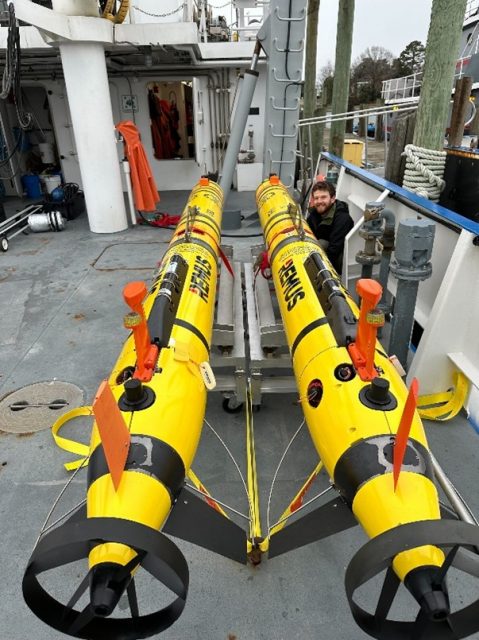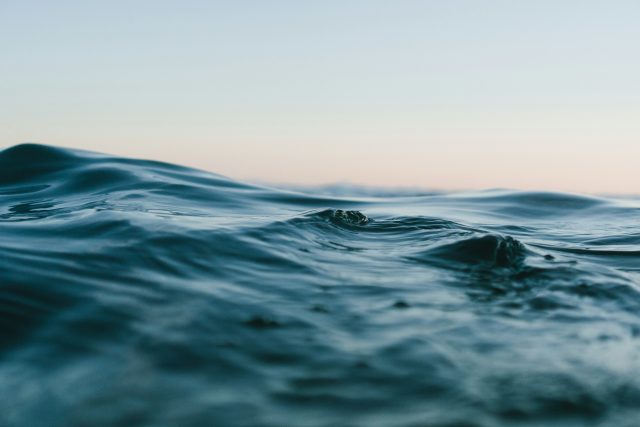News
Subsurface Temperature Anomalies off Central Oregon during 2014–2021
Brandy T. Cervantes, Melanie R. Fewings, and Craig M. Risien
Cervantes et al. (2024) use water temperature observations from a stationary oceanographic platform located in 80 m water depth off Newport, Oregon to calculate variations from the long term mean temperature at the surface, near surface, and bottom from 1999 to 2021. This site, known as NH-10, was occupied since 1999 successively by an Oregon State University National Oceanographic Partnership Program (OSU NOPP), GLOBEC Long Term Observation Program, Oregon Coastal Ocean Observing System (OrCOOS), NANOOS/CMOP. Since 2015 it has been occupied by the NSF OOI Coastal Endurance Oregon Shelf mooring (CE02SHSM). The temperature observations from these different programs that have not previously been combined into one long time series. Of particular interest are the details of the marine heatwave (MHW) periods of 2014–2016 and 2019– 2020, which had widespread impacts on marine ecosystems. Strong deviations from the mean water temperature observed near the ocean bottom during late 2016 are the largest sustained warm anomalies in the time series. The 2019–2020 period shows warm anomalies in the summer and fall that are only observed near the surface.
They also analyze the local winds during years with and without MHWs and find that spring/summer upwelling favorable, or northerly winds, which are important for bringing cold, nutrient rich water to the surface in coastal regions, interrupt MHW events and can lessen extreme heating during MHWs in coastal waters as illustrated in Figure 33.
The three periods detailed in Figure 33 show warmer daily surface temperatures during the MHW years than the non‐MHW years and several days during 2014–2016 with surface and bottom anomalies greater than 4°C and during 2014–2016 and 2019–2020 with surface anomalies greater than 4°C (Figure 12a). During upwelling favorable winds (negative wind stress), the three periods follow similar patterns with colder surface temperatures typically associated with higher wind stress magnitudes. During downwelling‐favorable winds (positive wind stress), 2014–2016 is substantially warmer at the surface than the other periods at all wind stress values.
[caption id="attachment_36388" align="alignnone" width="526"] Figure 33: 8‐Day low‐pass filtered surface temperature at NH‐10/CE02SHSM for (a) 1999–2000, (d) 2014–2015, and (g) 2019–2020; 8‐day low‐pass filtered along‐shelf surface velocity for (b) 1999–2000, (e) 2014–2015, and (h) 2019–2020; and NDBC 46050 wind stress vectors (thin light lines) and along‐shelf 8‐day wind stress (thick lines) (c) 1999–2000, (f) 2014–2015, and (i) 2019–2020. Events identified as surface marine heatwaves are shaded in gray. The thick black line in panels (a–b), (d–e), and (g–h) is the climatological mean computed over the full NH‐10 time series (Figure 33c), repeated twice, and the thin black lines are the 90th and tenth percentiles.[/caption]
Figure 33: 8‐Day low‐pass filtered surface temperature at NH‐10/CE02SHSM for (a) 1999–2000, (d) 2014–2015, and (g) 2019–2020; 8‐day low‐pass filtered along‐shelf surface velocity for (b) 1999–2000, (e) 2014–2015, and (h) 2019–2020; and NDBC 46050 wind stress vectors (thin light lines) and along‐shelf 8‐day wind stress (thick lines) (c) 1999–2000, (f) 2014–2015, and (i) 2019–2020. Events identified as surface marine heatwaves are shaded in gray. The thick black line in panels (a–b), (d–e), and (g–h) is the climatological mean computed over the full NH‐10 time series (Figure 33c), repeated twice, and the thin black lines are the 90th and tenth percentiles.[/caption]
___________________
References:
Cervantes, B. T., Fewings, M. R., & Risien, C. M. (2024). Subsurface temperature anomalies off central Oregon during 2014–2021. Journal of Geophysical Research: Oceans, 129, e2023JC020565. https://doi.org/10.1029/2023JC020565
Read MoreSoundscapes Spanning the Oregon Margin and 300 Miles Offshore
 Figure 32: An example of a daily spectrogram generated by the RCA Data Team spectrogram viewer. A Humpback whale song is visible throughout the day at ~40-1000 Hz. A chorus of Fin Whale vocalizations is visible at 20-40 Hz. A weather event is visible at 0100, and a ship passage at 2200.[/caption]
Figure 32: An example of a daily spectrogram generated by the RCA Data Team spectrogram viewer. A Humpback whale song is visible throughout the day at ~40-1000 Hz. A chorus of Fin Whale vocalizations is visible at 20-40 Hz. A weather event is visible at 0100, and a ship passage at 2200.[/caption]
The Regional Cabled Array (RCA) operates six broadband hydrophones that continuously capture soundscapes across the Cascadia Margin (Oregon Shelf and Oregon Offshore – seafloor), near the toe of the margin (Slope Base -seafloor and 200 m water depth) and 300 miles offshore at Axial Seamount (Axial Base – seafloor and 200 m water depth). The hydrophones, operational since 2014, capture signals from 10-64,000 Hz, including vessel traffic, marine mammal vocalization, wind, surf, and seismic events. The RCA broadband acoustic archive currently contains forty years (350,000 hours) of acoustic data in miniSeed format.
The RCA Data Team has developed a pipeline that can summarize and visualize a year of hydrophone data in 30 minutes. The spectrograms output (see Figure 32) by this pipeline are now easily accessible through an interactive viewer on the RCA’s Data Dashboard. The spectrogram viewer will make OOI-RCA broadband hydrophone data more searchable and accessible to data users and strengthen QA/QC of RCA acoustic data. Any day of hydrophone data, since 2014, will be viewable in minute/hybrid-millidecade resolution. The pipeline also enables users to convert RCA acoustic data to audio format (FLAC or WAV) in bulk. The spectrogram viewer was developed with input and guidance from the Ocean Data Lab at University of Washington and the Monterey Bay Aquarium Research Institute Soundscape team. It utilizes open source acoustic software tools – ooipy, pypam, and mbari-pbp.
Read MoreNow Available from BCO-DMO: Time Series Water Sample Data from Four OOI Arrays
OOI launched a collaboration in 2023 with the Biological & Chemical Oceanography Data Management Office (BCO-DMO) to make OOI water sampling data available via the BCO-DMO website and ERDDAP server. BCO-DMO curates publicly available research-ready oceanographic data in accordance with FAIR data principles. Advantages of distributing OOI data through BCO-DMO include concatenation of the cruise-by-cruise data into a single dataset with a Digital Object Identifier (DOI) and provisioning through ERDDAP, which provides both human and machine-to-machine interfaces. The BCO-DMO Dataset pages include descriptions of sampling and processing methods, and README files for each cruise.
Currently BCO-DMO has data from the OOI Station Papa Array (Gulf of Alaska, annual cruises over 11 years), Irminger Sea Array (North Atlantic, 10 years), Southern Ocean Array (SW of Chile, 6 years) and Argentine Basin Array (South Atlantic, 4 years). You can access the datasets via this direct link or from the BCO-DMO home page: Click on Projects, then search for “OOI Discrete CTD and Water Sampling Cruise Data”.
Figures 1 and 2 provide an example of the concatenated datasets using 10 years of data from the Irminger Sea Array. A Python script (implemented in a Jupyter Notebook available in https://github.com/WHOIGit/ooi-on-bco-dmo) was used to access the data from the BCO-DMO ERDDAP server, extract variables of interest, apply available quality control (QC) flags, and visualize the data. Figure 1 shows profiles of selected variables for successive cruises to give a sense of the depth-time data coverage. Note that the sample depths are relatively sparse since the OOI sampling goal is to validate instruments on the moorings rather than collect comprehensive profile data. Figure 2 represents profile variability over time by an overplot color-coded by year.
Even though constrained to “Acceptable” QC flags, some of the values plotted appear to be outliers, indicating the need for the user to consider further data quality assessment. Note that Discrete README files within the BCO-DMO dataset and CTD Cast Logs on OOI’s Raw Data Archive provide useful information. For example, the low values of oxygen in 2021are noted as inconsistent with oxygen from the CTD cast, whereas the high values of salinity in 2015 appear to be real, associated with a salinity maximum observed by the CTD. Since creating the Jupyter Notebook, data for two of the Irminger Sea cruises in OOI’s Raw Data Archive have been updated (including Nitrate for the 2021 cruise); these updates will be in the next version of the Irminger Sea dataset on BCO-DMO.
For additional Python scripts to explore OOI Discrete CTD and Water Sampling Cruise Data as distributed by BCO-DMO, for example to plot a discrete parameter against its corresponding CTD sensed parameter, see notebooks available in https://github.com/WHOIGit/ooi-on-bco-dmo/tree/main/notebooks.
[caption id="attachment_36331" align="alignnone" width="472"] Figure 1. Profiles of a) oxygen, b) salinity, and c) nitrate at the OOI the Irminger Sea Array from discrete bottle samples.[/caption]
[caption id="attachment_36332" align="alignnone" width="532"]
Figure 1. Profiles of a) oxygen, b) salinity, and c) nitrate at the OOI the Irminger Sea Array from discrete bottle samples.[/caption]
[caption id="attachment_36332" align="alignnone" width="532"] Figure 2. Temporal variability of a) oxygen, b) salinity, and c) nitrate over 10 years depicted as overlaid profiles.[/caption]
Read More
Figure 2. Temporal variability of a) oxygen, b) salinity, and c) nitrate over 10 years depicted as overlaid profiles.[/caption]
Read More Miniboats, Major Impact: The Legendary Returns to Sea with OOI Roots
In 2022, we shared a story of student-driven ocean exploration: a miniboat deployed from the R/V Neil Armstrong as part of the Educational Passages program, intersecting with the Ocean Observatories Initiative’s (OOI) Coastal Pioneer Array. That miniboat was one of many in a fleet of educational vessels aimed at engaging students in ocean science, data interpretation, and maritime technology. Today, we’re excited to provide a scientific update on one of the program’s longest-running vessels: The Legendary.
Originally built in 2018 by elementary students in Manchester, NH, The Legendary was designed to foster early engagement in oceanography and to introduce students to the physical and observational tools of marine science. During its maiden voyage, the boat passed near the OOI Pioneer Array and students used this opportunity to correlate real-time OOI measurements—like sea surface temperature, salinity, and currents—with the miniboat’s trajectory, deepening their understanding of ocean circulation and data-based prediction.
After making landfall in Portugal in October 2019 during its second voyage, The Legendary became a catalyst for international STEM collaboration. Portuguese students adopted the vessel at Agrupamento de Escolas Diogo de Macedo, refurbishing it and connecting virtually with their peers in New Hampshire to continue its mission of oceanic discovery.
In February 2025, The Legendary was finally relaunched into the Atlantic Ocean alongside another miniboat. Equipped with an upgraded GPS tracker, the vessel continues to serve as a student-driven observational platform. As it navigated wind and ocean currents, students tracked its progress, analyzing real-time environmental conditions, and drawing connections to large-scale oceanographic processes. After less than two weeks at sea, the boat made its way to Morocco, traveling nearly 600km. This new landing brings an opportunity for more students to come aboard the project, living up to its namesake: Legendary.
This long-duration project illustrates the synergy between Educational Passages and the OOI. While OOI provides continuous, real-time measurements of physical, chemical, and biological parameters across key regions of the global ocean, Educational Passages offers a scalable, accessible pathway for students to interact with those data. Through these programs, students aren’t just learning about the ocean – they’re participating in its observation and interpretation.
To follow The Legendary’s current voyage and read more about its evolution, visit the Educational Passages feature article: Crimson Voyager and The Legendary Relaunched from Portugal.
[caption id="attachment_36320" align="alignnone" width="640"]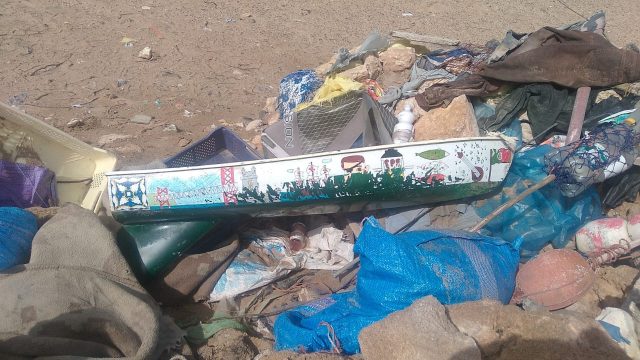 The Legendary landed on a sandy beach in Morocco, just south of Zaouiet Bouzarktoune. (c): Educational Passages[/caption]
[caption id="attachment_36321" align="alignnone" width="360"]
The Legendary landed on a sandy beach in Morocco, just south of Zaouiet Bouzarktoune. (c): Educational Passages[/caption]
[caption id="attachment_36321" align="alignnone" width="360"]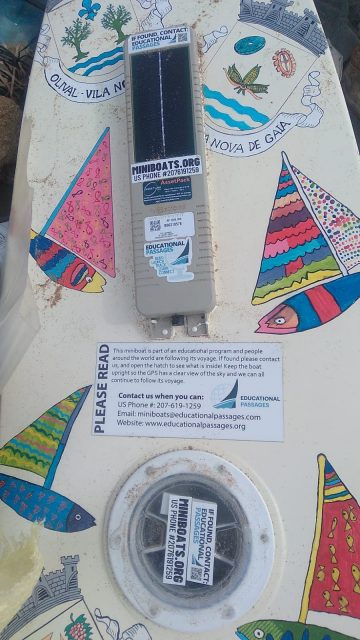 The Legendary (c): Educational Passages[/caption]
Read More
The Legendary (c): Educational Passages[/caption]
Read More Biofouling Preventatives on Surface Mooring Instrumentation
During the first leg of Pioneer 21, the team recovered the three surface moorings deployed in the Mid-Atlantic Bight (MAB) region, including the associated Multi-Function Nodes (MFNs) and Near-Surface Instrument Frames (NSIFs). Upon recovery, the state of the instrumentation at these sites showcased the effectiveness of biofouling mitigation strategies employed during this past year long deployment in the MAB region.
Biofouling — the accumulation of marine organisms such as algae, barnacles, and tube worms — is a challenge for sustained ocean observations. Unchecked growth can obstruct sensor faces, degrade data quality, and damage equipment. While complete prevention is rarely possible over extended deployments, targeted mitigation techniques can significantly limit biological overgrowth on critical sensing surfaces.
The following examples illustrate both the extent of biofouling on non-critical surfaces and the relative success of antifouling methods used to protect sensor interfaces:
[caption id="attachment_36259" align="alignnone" width="640"]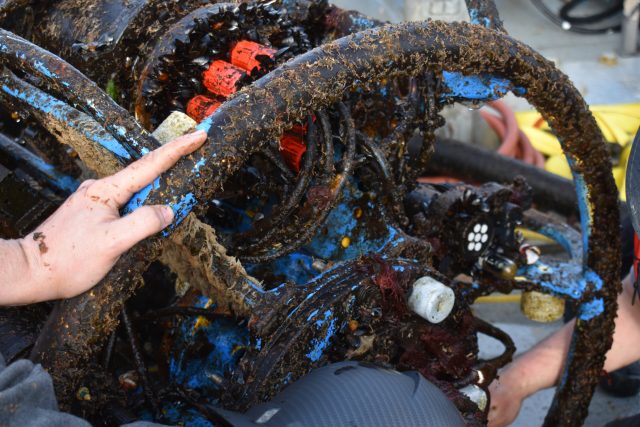 The seven white wavelength band sensing points of the Spectral Irradiance sensor (https://oceanobservatories.org/instrument-class/spkir/) in this image had been kept free from biofouling by a neighboring UV light that had been carefully positioned to illuminate the sensing region during throughout deployment. (c): Sawyer Newman, WHOI[/caption]
[caption id="attachment_36260" align="alignnone" width="640"]
The seven white wavelength band sensing points of the Spectral Irradiance sensor (https://oceanobservatories.org/instrument-class/spkir/) in this image had been kept free from biofouling by a neighboring UV light that had been carefully positioned to illuminate the sensing region during throughout deployment. (c): Sawyer Newman, WHOI[/caption]
[caption id="attachment_36260" align="alignnone" width="640"]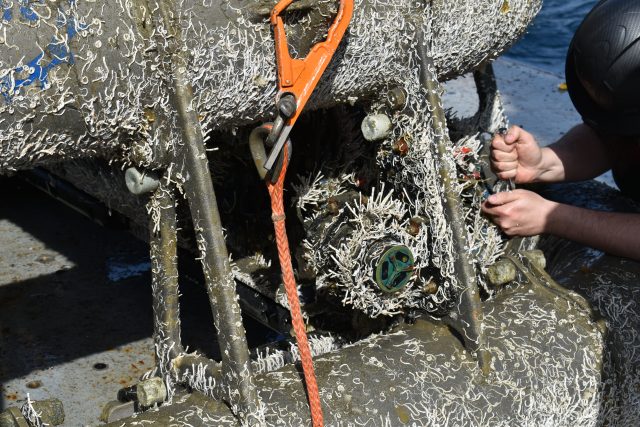 This photo shows a Fluorometer (FLORT) (https://oceanobservatories.org/instrument-class/fluor/) mounted to the SOSM-1 MFN used for turbidity sensing. This sensor face was kept clear from fouling by a rotating wiper. In contrast, tube worm growth is visible on non-sensing portions of the FLORT and adjacent structural elements of the MFN. (c): Sawyer Newman, WHOI[/caption]
[caption id="attachment_36261" align="alignnone" width="360"]
This photo shows a Fluorometer (FLORT) (https://oceanobservatories.org/instrument-class/fluor/) mounted to the SOSM-1 MFN used for turbidity sensing. This sensor face was kept clear from fouling by a rotating wiper. In contrast, tube worm growth is visible on non-sensing portions of the FLORT and adjacent structural elements of the MFN. (c): Sawyer Newman, WHOI[/caption]
[caption id="attachment_36261" align="alignnone" width="360"]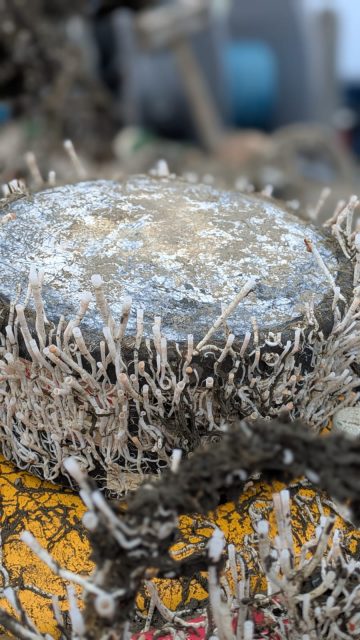 Zinc oxide cream (specifically, commercial diaper rash cream) was applied to the sensor faces of ZPLSCs (https://oceanobservatories.org/instrument-class/zpls/) prior to deployment. This image shows tube worm growth on the non-sensing parts of the ZPLSC, while the round sensing area, coated with zinc oxide, remained clear of biological growth. (c): Sawyer Newman, WHOI[/caption]
Zinc oxide cream (specifically, commercial diaper rash cream) was applied to the sensor faces of ZPLSCs (https://oceanobservatories.org/instrument-class/zpls/) prior to deployment. This image shows tube worm growth on the non-sensing parts of the ZPLSC, while the round sensing area, coated with zinc oxide, remained clear of biological growth. (c): Sawyer Newman, WHOI[/caption]
These observations underscore the importance of selecting and applying biofouling prevention strategies tailored to each sensor’s operational context and sensitivity. The recovery and evaluation of these assets offer critical feedback for ongoing sensor maintenance and instrument integration modifications.
Read MoreProf. Jack Barth Named Principal Investigator of the Ocean Observatories Initiative Cyberinfrastructure Data Center
The U.S. National Science Foundation’s Ocean Observatories Initiative (OOI) is pleased to announce that Dr. Jack Barth, oceanographer and Professor of Oceanography at the Oregon State University’s (OSU) College of Earth, Ocean, and Atmospheric Sciences (CEOAS), has been recently appointed as the Principal Investigator for the OOI Cyberinfrastructure Data Center operated out of OSU.
Dr. Barth brings extensive expertise in coastal ocean dynamics, marine ecosystems, and hypoxia, with a research focus on the complex spatial and temporal variations of coastal circulation and water properties and their influence on marine ecosystems. A leader in high-resolution ocean observations, he has played a pivotal role in advancing ocean observing systems and dissemination of the data they produce.
With a Ph.D. in Oceanography from the Massachusetts Institute of Technology and Woods Hole Oceanographic Institution Joint Program, Dr. Barth has led numerous research initiatives resulting in over 140 scientific papers, mentored more than 20 graduate students and postdoctoral scholars. His research interests include high-resolution observations from the inner continental shelf to the adjacent deep ocean in an eastern boundary current upwelling system; influence of physical processes on the formation of low-oxygen (hypoxic) zones on the continental shelf; and the development of ocean observing systems.
Dr. Barth was involved in the genesis of the OOI, attending the first community meeting in 2004, then serving on the NSF Ocean Research Interactive Observatory Network (ORION) Executive Steering Committee from 2004-2007. He led the Request for Assistance that resulted in the OOI Coastal Endurance Array. Jack served as Project Scientist with the OSU Implementing Organization through the building and installation of the Endurance infrastructure before stepping aside to lead the Marine Studies Initiative at OSU. In his return to the OOI, Dr. Barth will promote the Data Center and the use of its open access data for scientific research, educational activities and public outreach. He will work closely with other members of the CI team to improve the quality, accessibility, and usefulness of the data for a wide range of projects conducted by the user community.
Dr. Barth continues to shape the field through policy and advisory roles, including his just-completed service on the Oregon Ocean Policy Advisory Council’s (OPAC) Scientific and Technical Advisory Committee. A Fellow of The Oceanography Society and the American Meteorological Society, Dr. Barth’s role as Principal Investigator of the OOI will further strengthen the initiative’s mission to advance ocean observing science and technology. His leadership and expertise will help drive new innovations and enhance our collective understanding of ocean systems to support scientific discovery.
[caption id="attachment_36197" align="alignnone" width="350"] (c): Oregon State University[/caption]
Read More
(c): Oregon State University[/caption]
Read More Edson Represents OOI at POGO-26 Meeting in Malaysia
Jim Edson, Lead Principal Investigator of the NSF’s Ocean Observatories Initiative (OOI), recently attended the Partnership for Observation of the Global Ocean (POGO)-26 Meeting, held in Penang, Malaysia and hosted by the Centre for Marine and Coastal Studies (CEMACS). This international gathering brought together leading ocean researchers and policymakers to discuss issues and efforts in global ocean observation, capacity development, and outreach and advocacy.
The meeting covered a wide range of topics, including the role of blue carbon ecosystems in climate mitigation, biomolecular observations and environmental DNA (eDNA), sustainable ocean observation practices, digital twin technologies, marine heatwaves, and the far-reaching impacts of El Niño and La Niña on coastal and marine environments.
As part of the event, Edson participated in a panel discussion and delivered a presentation on the impact of El Niño and La Niña in the Northeast Pacific, drawing on a decade of Endurance Array data collected by OOI. His talk highlighted the importance of long-term oceanic datasets in understanding and predicting climate-driven changes in marine environments. The presentation sparked significant discussion among attendees, emphasizing the growing need for sustained ocean observations to improve forecasting, resource management, and climate resilience strategies.
Edson also provided an update on efforts to share metadata between the OOI and OceanSITES/OceanOPS. This effort will make the OOI surface mooring data more discoverable within this global network. This effort is led by the Coastal Global Scale Node (CGSN) team, which is conducting a pilot study using several methods to share the metadata. The OceanSITE component of this effort is supported by GOOS and represents a joint effort between the NSF, NOAA, POGO and GOOS.
By participating in POGO-26, Edson reinforced OOI’s role as a key contributor to global ocean monitoring efforts and OOI’s commitment to providing high-quality, long-term ocean data that can inform scientific research and decision-making worldwide.
[caption id="attachment_36143" align="alignnone" width="640"]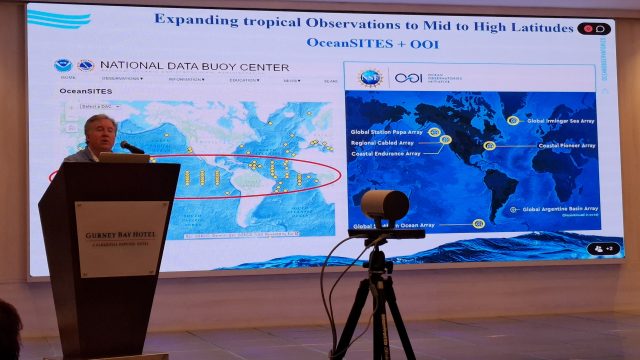 Jim Edson, OOI PI at presents at POGO-26[/caption]
[caption id="attachment_36144" align="alignnone" width="640"]
Jim Edson, OOI PI at presents at POGO-26[/caption]
[caption id="attachment_36144" align="alignnone" width="640"]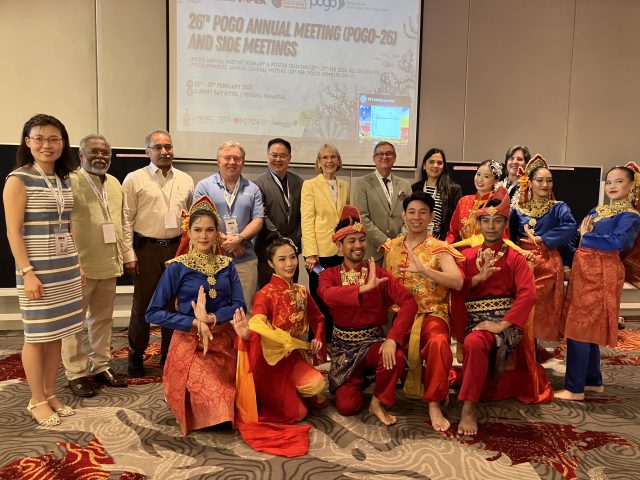 POGO-26 in Penang, Malaysia[/caption]
Read More
POGO-26 in Penang, Malaysia[/caption]
Read More Tagging and Tracking Large Fish Along the PNW Coast
A Navy-funded project is currently monitoring Pacific Salmon along the coasts of Oregon and Washington, using specialized tracking technology to better understand fish movements in near-real time. This effort, led by Dr. Taylor Chapple of Oregon State University, is part of the Marine Species Monitoring initiative, supported by the U.S. Navy Pacific Fleet.
While separate from the U.S. National Science Foundation’s Ocean Observatories Initiative (OOI) cruises, this project takes advantage of OOI’s Endurance Array moorings by placing Vemco VR2C tag readers on select moorings to detect and track tagged fish. The collected data provides valuable insights that could benefit commercial fishers, marine conservation efforts, and naval operations.
Tracking Salmon in Real-Time
As part of this initiative, researchers are tagging Pacific Salmon and tracking their movements using Vemco VR2C tag readers. These specialized instruments have been deployed on three OOI Endurance Array moorings: the Oregon Inshore Surface Mooring (CE01ISSM), the Washington Inshore Surface Mooring (CE06ISSM), and the Washington Shelf Surface Mooring (CE07SHSM).
When a tagged fish approaches one of these moorings, the tag reader records the encounter and transmits the data to shore within hours. This near-real-time data can be useful for commercial fishers, military operations, and other maritime stakeholders operating in the Pacific Northwest.
Expanding the Scope: Tracking Other Marine Life
Beyond salmon, the tag readers detect other marine species that have been tagged through separate research projects. These include sharks tagged from California to Alaska, sturgeon, other large fish, and even Dungeness crabs. The data collected from these detections is shared through OOI’s raw data server, contributing to a growing body of research on marine life movements in the region.
Data Access
To make the data easily available, each mooring with a tag reader generates a CSV file whenever it transmits data. These files have been combined into larger datasets, organized by mooring deployment, allowing researchers to analyze fish migration patterns and ecosystem dynamics.
By using OOI’s moorings for data collection, this project enhances our understanding of large fish movements along the Pacific Northwest coast, demonstrating the value of integrated ocean monitoring and advanced tagging technology.
To learn more and access the full dataset, visit the Tagging and Tracking of Large Fish Along the PNW Coast webpage.

Successful Underwater Surveys in the Mid-Atlantic Bight: OOI Team Deploys REMUS AUVs for Coastal Ocean Monitoring
Taking advantage of a period of calm weather, OOI staff successfully completed underwater surveys of the Pioneer Mid-Atlantic Bight (MAB) shelf and upper slope using OOI REMUS AUVs. With ab underway speed of over 3 knots, the AUVs provide synoptic transects of rapidly changing coastal systems – analogous to repeated “snapshots” of the ocean physical, biological, and nutrient conditions across the shelf capturing changes that occur over short time and spatial scales (meters to kilometers, and hours to one day).
The OOI Pioneer array was relocated from the New England Shelf (NES) to the southern Mid-Atlantic Bight in April 2024. AUV surveys previously conducted in the continental shelf waters offshore of New England now take place offshore of the sandy Outer Banks of North Carolina in a new and highly dynamic part of the US continental shelf. Moving the Pioneer Array to the MAB naturally resulted in some changes to operations, foremost being the use of new vessels (for this cruise, the R/V Virginia operated by the Virginia Institute of Marine Science). For efficiency, the AUVs are shipped fully assembled inside a 20 ft shipping container, along with all communications, control, and deck equipment. On arrival everything can be hoisted aboard and prepared for sea without needing re-integration that consumes valuable days on shore (Fig 1). The ships crane was modified by WHOI engineer Jared Schwartz to install the Ship of Opportunity Launch and Recovery System (SOO-LARS), a modular hydraulic winch system that OOI employs for safe and efficient deployment and recovery of these large AUVs on ships of several classes (Fig. 2).
The AUV operations at MAB derive from previous work at Pioneer NES. Once deployed, the AUVs run autonomously and sample in a series of saw-tooth profiles along a pre-programmed track, remaining in acoustic contact with the support vessel and surfacing periodically to update exact location from GPS. These plans were adapted for the MAB to compensate for the larger expanse of shelf traversed and the large changes in water column density between the shallow (25 m) inner shelf and deeper > 500 m upper slope. This is further complicated by density variations along the shelf and seasonally under the triple-influence of estuarine outflows, continental shelf processes, and the Gulf Stream just a few miles beyond the offshore extent of the sampling region (Fig 3). The MAB is also busy with a range of commercial, fishing, and military vessel traffic, offshore fixed installations, and ocean life in every shape and size imaginable. All factors that must be considered in advance and avoided underway by the invisible submerged AUVs. As was true for Pioneer NES, the support and knowledge of local vessel operators is vital to supporting at-sea operations and for meeting OOI’s science mission objectives.
The AUV data were offloaded from the vehicles after recovery. The data are discoverable in the OOI Data Explorer, and also available on the OOI raw data repository, following data format conversion and sensor post-calibration.
In addition to completing two consecutive surveys, each about 24 hours in length, the at-sea team of Andy Robinson, Collin Dobson, and Natalia Moore completed the scheduled recovery of the Offshore Mesoscale glider cp_379 (Fig. 4). A bonus accomplishment of this cruise was cross-training OOI staff new to AUV operations (Moore), made easier by the prevailing mild weather, experienced AUV techs, and the capable ship’s crew.
[gallery columns="2" size="large" ids="35942,35943,35944,35945"]Photo credits: Collin Dobson
Read MoreCommunity Datasets: Advancing Research and Collaboration through OOI Data
The U.S. National Science Foundation’s Ocean Observatories Initiative (OOI) is committed to providing open-access oceanographic data to advance research and collaboration. The revamped Community Datasets page now compiles value-added datasets contributed by researchers, showcasing the diverse applications of OOI data in ocean science.
This page serves as a resource for researchers, educators, and data scientists, providing easy access to datasets shaped by the broader scientific community. By highlighting these datasets, OOI aims to foster collaboration and encourage new research opportunities.
The Community Datasets page features datasets derived from OOI data available at Oceanobservatories.org. The value-added datasets are created by the user community and hosted on platforms like NOAA’s NCEI, the Woods Hole Open Access Server, and Zenodo. These data sets, and associated metadata, can be accessed via Digital Object Identifiers (DOIs).
Datasets currently highlighted on the OOI Community Datasets webpage include:
- Camargo, C. M. L. (2024). Shelfbreak jet transport from OOI Pioneer.
DOI: 10.5281/zenodo.10814048 - Le Bras, Isabela (2023). Water temperature and salinity profiles from the OOI Global Irminger Sea Array Apex profiler mooring (2014-2020). NOAA National Centers for Environmental Information.
DOI: 25921/wzvr-fk49 - Lobert, Lukas, Gawarkiewicz, Glen G., Plueddemann, Albert J. (2023). Gridded hydrography and bulk air-sea interactions observed by the OOI Coastal Pioneer New England Shelf Mooring Array (2015-2022). Woods Hole Open Access Server.
DOI: 26025/1912/66379 - McRaven, L. (2021). Near-real-time CTD data from Irminger 8 cruise (August 2021). Ocean Observatories Initiative.
Retrieved from: https://oceanobservatories.org/2021/09/near-real-time-ctd-data-from-irminger-8-cruise-august-2021/ - McRaven, Leah (2022). Water temperature, salinity, and others taken by CTD and Niskin bottles from the research vessel Neil Armstrong (August 2021). NOAA National Centers for Environmental Information.
DOI: 25921/p8qe-me08 - Risien, Craig, Cervantes, Brandy, Fewings, Melanie, Barth, John, Kosro, P. Michael (2023). A Stitch in Time: Combining More than Two Decades of Mooring Data from the Central Oregon Shelf (v1.0).
DOI: 10.5281/zenodo.7582475 - Toole, John M., Musgrave, Ruth C., Fine, Elizabeth C., Steinberg, Jacob M., Krishfield, Richard A. (2023). Near-full-depth profile observations of water properties and currents at four deep-ocean sites. Woods Hole Open Access Server.
DOI: 26025/1912/66426 - Wilcock, William, Tolstoy, Maya, Waldhauser, Felix (2017). Catalogs of earthquakes recorded on Axial Seamount (January–November 2015). Marine Geoscience Data System (MGDS).
DOI: 1594/IEDA/323843
A key feature of this initiative is its community-driven approach. Researchers from diverse institutions have collaborated to compile and share these datasets, ensuring their broader impact. In addition to accessing datasets, researchers are encouraged to contribute their own derived datasets. Those interested in sharing their work can reach out to the OOI HelpDesk for support.
The Community Datasets page is a valuable resource for researchers, promoting data accessibility, collaboration, and scientific innovation. By sharing and expanding the use of OOI data, the community continues to drive groundbreaking discoveries in ocean science.
Explore the Community Datasets Page → https://oceanobservatories.org/community-data-tools/community-datasets/
Read More


